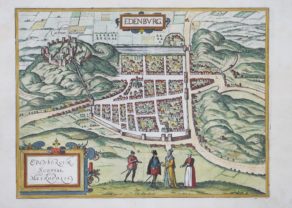Title page of Theatrum Imperii Magnae Britanniae
Detail
Date of first edition: 1612 (made in 1610)
Date of this edition: 1616
Dimensions (not including margins): 38,2 x 24,2 cm
Dimensions (including margins): 40,5 x 26,6 cm
Condition: very good. Sharp copper engraving. Good margins. Slightly age-toned.
Condition rating: A
Verso: blank
Reference: R. Shirley, map 32, page 100
From: Theatrum Imperii Magnae Britanniae
In stock
The title page
The architectural frame for the Theatrum Imperii Magnae Britanniae has been derived from the title page of the Theatrum of Ortelius.
John Speed shows the people who conquered and inhabited the island. Prominent in the top center is A Britaine. This may be a Pict, as engraved by Theodor de Bry in 1590. Next to and below him are a Roman, a Saxe, a Dane and a Norman, the “ethnic composition” of the people of 17th Century Britain. Each of them is garbed according to their epoch. Above or beside them are their armorial shields and at the foot of the titlepage are two small vignettes: one of London and another of a ship.
The title page is unsigned. It is generally attributed to Jodocus Hondius himself, but may have come from engraver Renold Elstrack (1570-c. 1625).
This title page was successful and was later used in 1645 and 1646 as inspiration for title pages by Blaeu and Janssonius.
Related items
-

Kent – Kent with her Cities and Earles Described and Observed
by John SpeedPrice (without VAT, possibly to be added): €1 200,00 / $1 332,00 / £1 068,00 -

Herefordshire
by John SpeedPrice (without VAT, possibly to be added): €500,00 / $555,00 / £445,00 -

Hertfordshire
by John SpeedPrice (without VAT, possibly to be added): €900,00 / $999,00 / £801,00 -

Lancashire and the War of Roses
by John SpeedPrice (without VAT, possibly to be added): €1 600,00 / $1 776,00 / £1 424,00A unique map







John Speed
John Speed (1551 or ’52 – 28 July 1629) was the best known English mapmaker of the Stuart period. Speed came to mapmaking late in life, producing his first maps in the 1590s and entering the trade in earnest when he was almost 60 years old.
John Speed’s fame, which continues to this day, lies with two atlases, The Theatre of the Empire of Great Britaine (first published 1612), and the Prospect of the Most Famous Parts of the World (1627). While The Theatre … started as solely a county atlas, it grew into an impressive world atlas with the inclusion of the Prospect in 1627. The plates for the atlas passed through many hands in the 17th century, and the book finally reached its apotheosis in 1676 when it was published by Thomas Bassett and Richard Chiswell, with a number of important maps added for the first time.